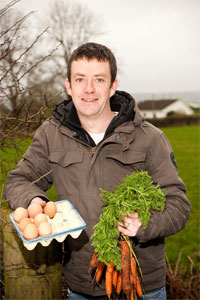Grow it Yourself - December
 I had a bit of a panic last weekend when it occurred to me that I hadn’t sown anywhere near enough spinach or chard when I did my ‘winter sowing’ back in September. I’m a big fan of spinach, particularly in the winter months when there are few other sources of leafy greens in the vegetable patch.
I had a bit of a panic last weekend when it occurred to me that I hadn’t sown anywhere near enough spinach or chard when I did my ‘winter sowing’ back in September. I’m a big fan of spinach, particularly in the winter months when there are few other sources of leafy greens in the vegetable patch.
I love using tiny little spinach leaves in salads and larger ones in stir-fries, soups and the likes. But problem is, I reckon I only have enough left in the veg patch to see me up to Christmas. Which would leave with me with at least 2-3 months in the New Year ‘spinach free’.
Spinach is a nutritional powerhouse – calorie for calorie it provides more nutrients than any other food. It is rich in vitamins and minerals, and concentrated anti-oxidant phytonutrients. It is thought to be anti-inflammatory and anti-cancer, and provides more than you could ever need of vitamins A, C and K (over 1000% of your recommended intake). It’s no wonder that it made Popeye so healthy. Nutritionists recommend a one-cup serving of spinach, at least twice a week.
 So anyway last weekend I decided to sow another tray of spinach, more in hope than expectation really (given that we’re in the middle of Winter and most grower’s guides advise not sowing it beyond September). I put the module tray on a warming mat in the potting shed and lo and behold within 3 or 4 days it germinated and is already showing very promising signs of life.
So anyway last weekend I decided to sow another tray of spinach, more in hope than expectation really (given that we’re in the middle of Winter and most grower’s guides advise not sowing it beyond September). I put the module tray on a warming mat in the potting shed and lo and behold within 3 or 4 days it germinated and is already showing very promising signs of life.
I assume the constant ‘heat from beneath’ was instrumental in helping it to germinate, but either way it gave me such a buzz to see anything germinate at this time of the year. I will be planting it out in the polytunnel in a few weeks, where I assume it may need a fleece covering in very cold weather.
Here’s hoping for a healthy crop of baby leaves in January. Happy Christmas from GIY.
Things to do this month
To Do
As you clear remaining crops from your veggie patch, dig the beds over and add well rotted compost or manure. Get Educated – book yourself on a course! Start planning what you would like to grow next year and work out what crop rotation system you are going to use. Study seed catalogues carefully before deciding on the best varieties to grow. Start a Compost corner or heap. Keep an eye on your stored veggies and discard anything that’s rotting. Collect and store leaves in bags to make leaf mould or use as cover for bare soil.
Sow
If you haven’t already done so plant garlic – it should be in the soil by the shortest day of the year. Bring herbs like mint, chives, lemon balm, parsley, thyme indoors by lifting and potting them up.
Harvest
Buck the seasonal trend by continuing to harvest winter salad leaves like corn salad, land cress and mizuna. You should still have at least some produce left in the December veggie patch e.g. winter cabbages, Brussels sprouts, leeks, kale, Jerusalem artichokes, carrots, celery, turnips, parsnips, winter cauliflowers, swedes, spinach, chard and celeriac.
From your stores you can enjoy pumpkins and squashes, potatoes, onions, apples, beetroot and garlic.
Recipe of the Month – How to Cook Spinach
The key to preserving the nutritional value, flavor and consistency of spinach is NOT to overdo the cooking. A couple of minutes in a pan is more than enough.
Ingredients:
• 2 large bunches of spinach, about 1 lb
• 2 tablespoons olive oil
• 3 cloves garlic, sliced
Directions:
Cut off the thick stems of the spinach and discard. Rinse the spinach under a tap to remove any soil or dirt. Put the spinach in a lettuce spinner to remove any excess moisture – this is important.
Heat the olive oil in a large pan on a medium heat – add the garlic and cook gently for about 1 minute, until the garlic is just beginning to brown. Add the spinach and turn it with a spatula so that it all gets covered in the oil and garlic.
Cover the pan and cook for 2 minutes, turning it once. You want to get it out of the pan just as it wilts.
Drain any excess moisture from the pan and serve it up. Add a little more olive oil and then season to taste. A tablespoon or two of soya sauce and a sprinkle of sesame seeds, added just before serving will liven things up a bit and give it an asian aroma.
Tip of the Month – How to Grow Spinach
Given its propensity to bolt, succession sowing is the key if you want a constant supply of spinach during the season. Sow in module trays, 1.5 cm deep every three weeks from April to September. Sow three or four seeds in each module.
You can also sow direct in the soil outside if you wish, but slugs can be a problem as the tiny seedlings are getting established. Transplant to final growing spot, leaving 25cm between rows and 7-15cm between plants (depending on whether you want baby leaves or regular ones).
Spinach can be grown pretty much anywhere and doesn’t need to be included in your rotation – use it as a flexible filler and for intercropping. Summer sowings should be done in partial shade to prevent bolting.
Water copiously particularly in summer – as soon as the plant dries out, it will bolt. Apply an organic liquid feed (nettle is good – high in nitrogen) if growth seems lacklustre.
------------------------------------
We are trying to get 100,000 people to take a pledge to grow something they can eat – take the GIY pledge at www.facebook.com/giyireland.
 Michael Kelly is a freelance journalist, author and founder of GIY Ireland.
Michael Kelly is a freelance journalist, author and founder of GIY Ireland.
GIY’s purpose is to transform people’s health and wellbeing, stenghten communities and protect the environment by empowering people to grow their own food. We do this by bringing people together in communities and online to share tips and information. There are nearly 100 GIY groups around Ireland and 12,000 GIYers involved.
For more tips, information and support visit www.giyireland.com.
© GIY Ireland 2011 – all rights reserved.





There are currently no comments
Leave a comment
Not a member? Register for your free membership now!
Or leave a comment by logging in with: